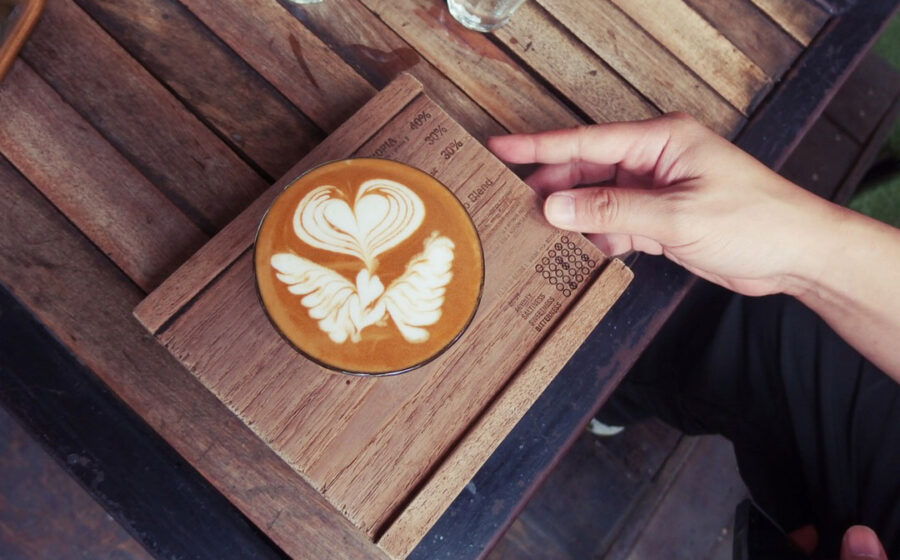[Y]ears ago, I was tasked with training a new trainer at our company, so I took him through our normal curriculum. We learned about the seed-to-cup process, how to brew coffee, and how to make espresso drinks to our standards.
On the last day, we sat down in front of the TV, put in a video produced by David Schomer, and gazed in wonder at the people pouring designs into their lattes with the milk. With the milk! They were pouring one liquid into another liquid, and beyond belief, they were able to bend it to their will.
“Let’s do it,” my new coworker said. “Let’s pour some latte art.”
It won’t matter how crooked your rosetta came out. You’ve shown your customer that you care.
Like waves crashing against a rocky coast, we threw ourselves into the task, and repeatedly failed. It seemed impossible. At the time, it was. We hadn’t mastered milk steaming, and our fluffy, meringue-like milk didn’t lend itself to artistry. It was years before I poured a latte that looked amazing. In fact, I poured lattes for years before I learned that there was such a thing as latte art. In fact, I poured lattes for years before I even knew that steaming milk intentionally and carefully produces drinks that don’t just look better, they taste better as well. It was years before I realized that I was treating one of my two main ingredients with little, if any, care. None of my customers had complained, so I assumed everything was great. I didn’t see the gulf between “not complaining” and “completely satisfied.”
When I understood that difference and when I understood that drinks with a poor appearance were a sign of poor preparation, I knew I needed to change my approach. I have never wanted to make drinks that could be charitably described as passable. I want to blow people away. Latte art became part of my craft.
Once you’re steaming your milk well, pouring lattes that look as good as they taste is not far from your reach. With just a little bit of guidance, you can start making drinks with beautiful definition and contrast.
It starts, of course, with milk that has been steamed with consideration, as we discussed last month. Milk left under the steam wand to cook until the auto-shut off mechanism in the thermometer kicks in is milk with little hope. Attentive steaming, however, recognizes that the hottest drinks aren’t the best drinks, and a barista that stops the steaming process around 150 degrees is a friend of all. She also holds the tool needed to make latte art.
We’ve come to the moment of truth. Before you sits a small cup that contains espresso and hope. In your hand is a pitcher filled with creamy microfoamed milk and potential.
Take the pitcher in your hand and swirl it several times to integrate the liquid milk and foam so the viscosity becomes consistent through the whole pitcher. You’re going to pour this drink in one continuous motion, like a pro. There are no spoons in your world anymore—just skills.

The first part of the pour lays the foundation for the rest. You’re going to pour slowly enough that the milk pierces the crema and begins to fill the cup from below without sloshing up the side of the cup. It should almost look like the cup is filling with espresso. As you near two-thirds full, pour faster.
This is my most common command during a milk-pouring training session: faster. You really need to pour not just fast, but faster. Probably faster than you’re imagining right now. The purpose of the faster pour is to get the milk foam that’s floating on the surface of the milk in the pitcher to come out and integrate on the surface of the beverage.
At the end of the pour, as the cup is nearly filled, slow down your pour, and stop before it overflows (which is advice that’s often not followed). If everything went well, you should have a pure white shape of some sort in the middle of a ring of dark brown crema. You’ve just poured your first latte art. Is it impressive? Not especially. Will you share it on social media? Maybe not. But the technique gained by producing this shape is what you need to create photo-worthy latte art. Fantastic shapes, like hearts and tulips and rosettas, come with practice. Hours and hours of practice. The time can seem daunting, and the progress can be slow, but it’s worth it. The feeling of accomplishment when you pour something that looks even a little bit like anything is wonderful. I’ve posted pictures on social media of pours that I look back on now with a cringe. I thought I was doing so well, and I wasn’t.
At the time, though? I felt amazing! And you will too! The key is not to expect extraordinary results right away and to celebrate progress, no matter how little it appears. You are showing commitment to your customers’ enjoyment and satisfaction, and that’s huge. There will always be baristas somewhere in the world pouring better latte art than you, but you’re the only person pouring lattes for your customers. They are your audience. Impress them, and it won’t matter how lopsided your heart is or how crooked your rosetta came out. You’ve shown them that you care.
As they drink their latte, ruining even a perfect heart, that’s what will stick with them the most. You care.
—Nathanael May is a regular contributor to Fresh Cup. He is Portland Roasting Coffee’s director of coffee.
















